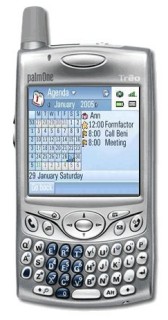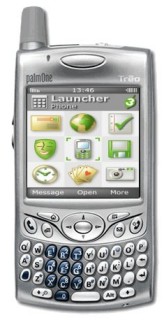 Are there going to be any surprises from Symbian at The Smartphone Show? Probably, but the question will be how big are these surprises, and will they be aimed at developers, existing licencees, or at the broad marketplace? So gather round our Crystal Ball...
Are there going to be any surprises from Symbian at The Smartphone Show? Probably, but the question will be how big are these surprises, and will they be aimed at developers, existing licencees, or at the broad marketplace? So gather round our Crystal Ball...
I can see Nigel Clifford at the keynote. He’s taking about a new licensee, with history in mobile devices and smartphones – the mist is thick, I can’t make out anything on the screen, but someone is walking in from the wings as Clifford welcomes his latest signing to the stage. Ed Colligan. Palm, inc. are taking Symbian OS with UIQ 3.0 to power the Palm Treo.
So is this the way of the future or just a crazy vision? Let me explain.
Firstly, never lose sight of who Symbian’s customers are. They are not you or I. Nor are they developers. They have one product, Symbian OS, and this is sold to a handful of handset manufacturers. Everything else is incidental. If Symbian are not talking to every handset manufacturer in the world, then the sales team aren’t up to scratch.
“But Nokia won’t like Palm as a licensee!” I hear you say. Well, if you follow that thinking through then Nokia wouldn’t like the whole UIQ concept, which is owned by Symbian. They wouldn’t like any other phone apart from their own running the OS. So ask again why Nokia are in Symbian, and then forget about notions that Nokia wouldn’t welcome Palm to the table.
But most of the building blocks to this idea are from the Palm side of things. Colligan, now the CEO of Palm, has been around since before the launch of the Pilot 1000, many, many years ago. So he’s been in many wars and already faced down Microsoft and the Palm PC machines previously. Rumours of a Windows Mobile powered Treo are growing on a daily basis, and I for one am certain we will see one of those this side of 3GSM 2006. So if he’s made the decision to go multi-OS in his product line, the hardest decision has already been made.
 Palm is in desperate need of a multi-tasking, multi-threaded operating system that can handle the modern day requirements of a smartphone (e.g. a push email client, IM client and web browser all running at the same time). PalmSource as yet can’t provide this in a stable form using their Cobalt platform – they’re relying on a Linux base to appear in the next two to three years. Palm OS is fine for standalone PDAs such as the Zire, and Palm don’t want PalmSource (now of course owned by Access) going anywhere. Perhaps that’s why the renewed licence between the companies announced in May has Palm paying a guaranteed minimum number of unit sales per year to PalmSource? With that income stream in place, PalmSource can take their time polishing the Linux OS variant.
Palm is in desperate need of a multi-tasking, multi-threaded operating system that can handle the modern day requirements of a smartphone (e.g. a push email client, IM client and web browser all running at the same time). PalmSource as yet can’t provide this in a stable form using their Cobalt platform – they’re relying on a Linux base to appear in the next two to three years. Palm OS is fine for standalone PDAs such as the Zire, and Palm don’t want PalmSource (now of course owned by Access) going anywhere. Perhaps that’s why the renewed licence between the companies announced in May has Palm paying a guaranteed minimum number of unit sales per year to PalmSource? With that income stream in place, PalmSource can take their time polishing the Linux OS variant.
Palm can’t wait that long, they need something that works now. And they probably started work with Microsoft at the start of 2005 (if not before) to work on the Windows Powered Treo. As to the brand name Palm, all of these rights were purchased back by Palm, inc. from PalmSource just after the licencing deal. There’s nothing to stop Palm branding a Windows Treo as being a Palm device. And in recent surveys, the significant majority of users associate Palm with the hardware and not the software that’s running on it.
OK, so it’s a given that Palm can switch the OS in their Treo phones without significantly harming the market or major business relations. So why the link to Symbian?
Simple question – would you bet your entire company's mobile strategy on Microsoft? A company that has been trying to squeeze Palm in the PDA market for a number of years? Would you make yourself beholden to their licence terms? Or would you make sure you had a second option?
And that second option can only, realistically, be Symbian. If you’re happy to go with a multi-OS approach, there is nothing to stop them launching a Symbian OS-based Treo. UIQ 3.0 should be on show in October and in production phones during Q1 2006. The UI/skinning option has already been demonstrated, and Palm working with UIQ to get a “Palm UI” look and feel on the phones would not be a massive undertaking. The UIQ classic skin, in any case, has many of the artefacts in place from Palm OS (e.g. categories and pick lists). It is eerily similar, but not enough to warrant second looks from a lawyer. It provides the same level of functionality, and speaking to some Palm users who have made the switch, they’re very comfortable with UIQ. Now add in the ability to tweak the UI layer in UIQ 3.0... and you now have both the will and means to make a Symbian/Palm marriage viable.
Palm gains itself a modern OS that it can mould to look exactly like everything else - the Windows Mobile Treo shows they’re happy to break compatibility for the right product (in any case Symbian OS 9.1 does this with previous Symbian apps). Symbian gain a new licencee that, while it may not have the bulk selling power of others, has a huge mind share and could finally break open the American market to this Symbian thing. Palm gain all the tools and power they need to push their vision of a smartphone out to the world, while maintaining their independence.
Looks like that it might be crazy after all – no-one is going to believe in a deal that benefits all sides…
Links:
- Our sister site, All About Palm.
